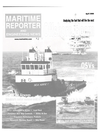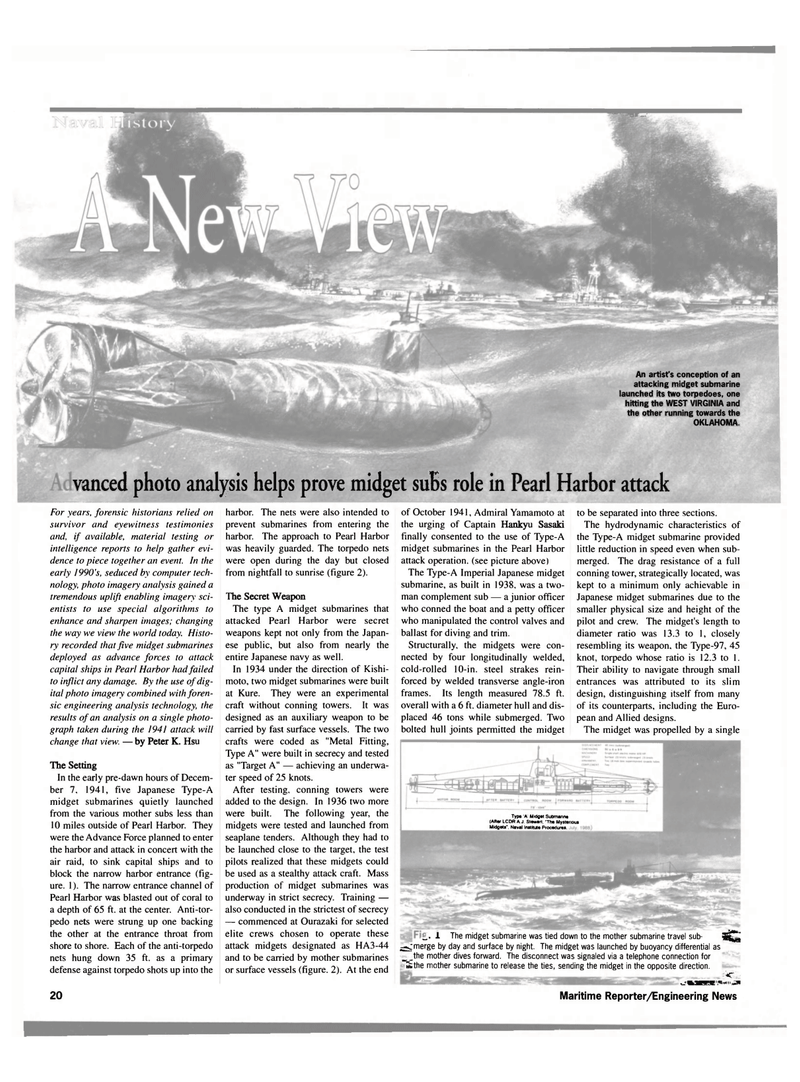
Page 20: of Maritime Reporter Magazine (April 2000)
Read this page in Pdf, Flash or Html5 edition of April 2000 Maritime Reporter Magazine
vanced photo analysis helps prove midget subs role in Pearl Harbor attack
An artist's conception of an attacking midget submarine launched its two torpedoes, one hitting the WEST VIRGINIA and the other running towards the
OKLAHOMA.
For years, forensic historians relied on survivor and eyewitness testimonies and, if available, material testing or intelligence reports to help gather evi- dence to piece together an event. In the early 1990's, seduced by computer tech- nology, photo imagery analysis gained a tremendous uplift enabling imagery sci- entists to use special algorithms to enhance and sharpen images; changing the way we view the world today. Histo- ry recorded that five midget submarines deployed as advance forces to attack capital ships in Pearl Harbor had failed to inflict any damage. By the use of dig- ital photo imagery combined with foren- sic engineering analysis technology, the results of an analysis on a single photo- graph taken during the 1941 attack will change that view. — by Peter K. Hsu
The Setting
In the early pre-dawn hours of Decem- ber 7, 1941, five Japanese Type-A midget submarines quietly launched from the various mother subs less than 10 miles outside of Pearl Harbor. They were the Advance Force planned to enter the harbor and attack in concert with the air raid, to sink capital ships and to block the narrow harbor entrance (fig- ure. 1). The narrow entrance channel of
Pearl Harbor was blasted out of coral to a depth of 65 ft. at the center. Anti-tor- pedo nets were strung up one backing the other at the entrance throat from shore to shore. Each of the anti-torpedo nets hung down 35 ft. as a primary defense against torpedo shots up into the harbor. The nets were also intended to prevent submarines from entering the harbor. The approach to Pearl Harbor was heavily guarded. The torpedo nets were open during the day but closed from nightfall to sunrise (figure 2).
The Secret Weapon
The type A midget submarines that attacked Pearl Harbor were secret weapons kept not only from the Japan- ese public, but also from nearly the entire Japanese navy as well.
In 1934 under the direction of Kishi- moto, two midget submarines were built at Kure. They were an experimental craft without conning towers. It was designed as an auxiliary weapon to be carried by fast surface vessels. The two crafts were coded as "Metal Fitting,
Type A" were built in secrecy and tested as "Target A" — achieving an underwa- ter speed of 25 knots.
After testing, conning towers were added to the design. In 1936 two more were built. The following year, the midgets were tested and launched from seaplane tenders. Although they had to be launched close to the target, the test pilots realized that these midgets could be used as a stealthy attack craft. Mass production of midget submarines was underway in strict secrecy. Training — also conducted in the strictest of secrecy — commenced at Ourazaki for selected elite crews chosen to operate these attack midgets designated as HA3-44 and to be carried by mother submarines or surface vessels (figure. 2). At the end of October 1941, Admiral Yamamoto at the urging of Captain Hankyu Sasaki finally consented to the use of Type-A midget submarines in the Pearl Harbor attack operation, (see picture above)
The Type-A Imperial Japanese midget submarine, as built in 1938, was a two- man complement sub — a junior officer who conned the boat and a petty officer who manipulated the control valves and ballast for diving and trim.
Structurally, the midgets were con- nected by four longitudinally welded, cold-rolled 10-in. steel strakes rein- forced by welded transverse angle-iron frames. Its length measured 78.5 ft. overall with a 6 ft. diameter hull and dis- placed 46 tons while submerged. Two bolted hull joints permitted the midget to be separated into three sections.
The hydrodynamic characteristics of the Type-A midget submarine provided little reduction in speed even when sub- merged. The drag resistance of a full conning tower, strategically located, was kept to a minimum only achievable in
Japanese midget submarines due to the smaller physical size and height of the pilot and crew. The midget's length to diameter ratio was 13.3 to 1, closely resembling its weapon, the Type-97, 45 knot, torpedo whose ratio is 12.3 to 1.
Their ability to navigate through small entrances was attributed to its slim design, distinguishing itself from many of its counterparts, including the Euro- pean and Allied designs.
The midget was propelled by a single 20 Maritime Reporter/Engineering News
Type A' Midget Submarine (After LCDR A.J. Stewart. "The Mysterious
Midgets", Naval Institute Procedures. _ The midget submarine was tied down to the mother submarine travel sub- gjQj ^ merge by day and surface by night. The midget was launched by buoyancy differential as
Jhe mother dives forward. The disconnect was signaled via a telephone connection for " ithe mother submarine to release the ties, sending the midget in the opposite direction. — — ijg*' - •t-^'Wh JilHEffflf.1, *!. J i'1111 w

 19
19

 21
21
